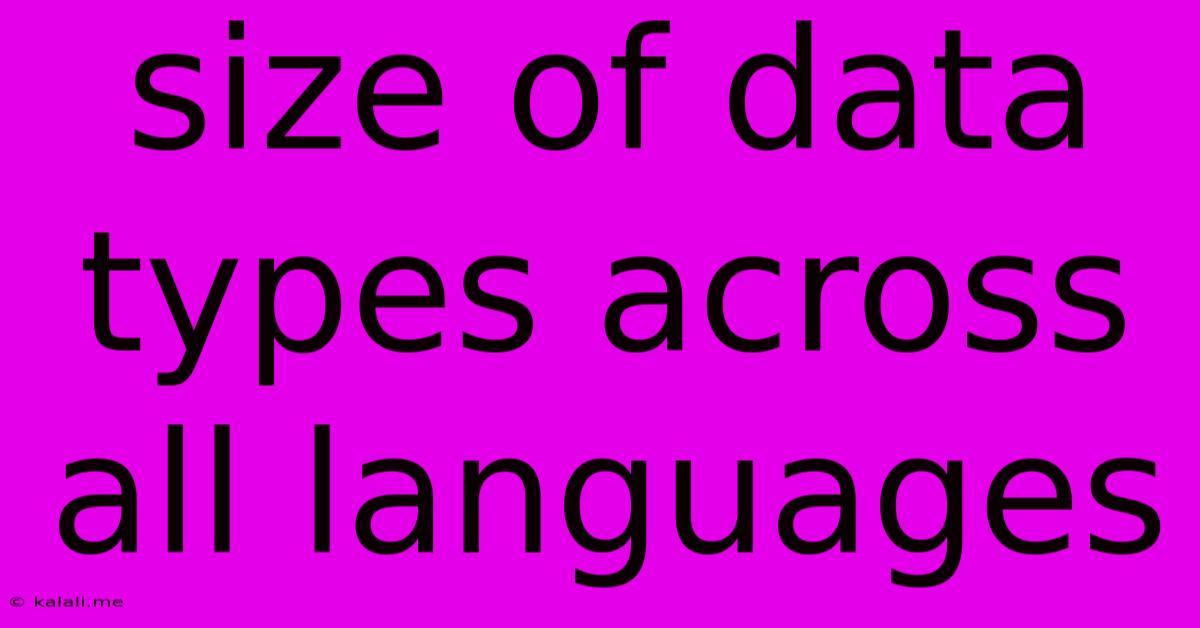Size Of Data Types Across All Languages
Kalali
Jun 05, 2025 · 3 min read

Table of Contents
The Size of Data Types Across Programming Languages: A Comprehensive Guide
Understanding data type sizes is crucial for any programmer, impacting memory management, performance optimization, and cross-platform compatibility. This comprehensive guide explores the common data types and their sizes across various popular programming languages. Note that these sizes can vary slightly depending on the compiler, operating system, and system architecture (32-bit vs. 64-bit). Always consult your specific compiler documentation for precise details.
Why Data Type Size Matters
The size of a data type directly influences how much memory it occupies. Larger data types consume more memory, potentially impacting performance, especially when dealing with large datasets or memory-constrained environments. Conversely, using smaller data types when appropriate can lead to memory savings and efficiency gains. Understanding these sizes is also vital for data exchange between systems and languages, ensuring compatibility and avoiding data corruption. For instance, you need to be mindful of potential integer overflow issues when working with data types that have limited size.
Common Data Types and Their Sizes:
The table below summarizes the typical sizes of common data types in several popular programming languages. Remember, these are typical values and may differ based on the factors mentioned earlier.
| Data Type | C/C++ | Java | Python (CPython) | JavaScript | Go |
|---|---|---|---|---|---|
| Integer Types | |||||
int |
4 bytes (usually) | 4 bytes | platform-dependent | platform-dependent | 4 bytes (int32) |
long |
4 or 8 bytes | 8 bytes | platform-dependent | platform-dependent | 8 bytes (int64) |
short |
2 bytes | 2 bytes | platform-dependent | platform-dependent | 2 bytes (int16) |
char |
1 byte | 2 bytes (Unicode) | 1 byte | 2 bytes (Unicode) | 1 byte |
| Floating-Point Types | |||||
float |
4 bytes | 4 bytes | platform-dependent | platform-dependent | 4 bytes |
double |
8 bytes | 8 bytes | platform-dependent | platform-dependent | 8 bytes |
long double |
8 or 16 bytes | Not directly supported | platform-dependent | platform-dependent | Not directly supported |
| Boolean Types | |||||
bool |
1 byte (usually) | 1 byte | platform-dependent | platform-dependent | 1 byte |
Language-Specific Considerations:
-
C/C++: The sizes of integer types can be compiler and platform-dependent. Using
stdint.hprovides fixed-size integer types (likeint32_t,int64_t) for more consistent behavior across different systems. -
Java: Java's data types have relatively consistent sizes across different platforms due to the Java Virtual Machine (JVM).
-
Python: Python's integer types are dynamic and can grow to accommodate arbitrarily large numbers. The size isn't fixed like in C++ or Java. Floating-point types are also platform dependent.
-
JavaScript: JavaScript uses double-precision floating-point numbers for all numerical values, leading to potential precision issues.
-
Go: Go offers explicit sizes for integer types, promoting cross-platform consistency.
Best Practices for Handling Data Types
-
Choose appropriate data types: Select the smallest data type that can accommodate your data to optimize memory usage and performance.
-
Be aware of platform dependencies: Understand the potential variations in data type sizes across different platforms and compilers.
-
Use fixed-size integer types (where available): Employ fixed-size integer types like
int32_torint64_tin C/C++ and other languages to avoid platform-dependent variations. -
Consider data structures: Efficient data structures can reduce memory consumption and enhance performance.
-
Perform thorough testing: Rigorous testing is crucial to ensure your code handles different data types and sizes correctly across various environments.
By understanding the sizes and characteristics of data types across different programming languages, developers can write more efficient, portable, and robust code. This knowledge is essential for creating applications that perform well and avoid unexpected errors related to memory management and data representation.
Latest Posts
Latest Posts
-
Is Policy Changes A Noun Or Verb
Jun 06, 2025
-
Se Puede Deshacer El Rgb Outline En Illustrator
Jun 06, 2025
-
Reasons Cron Job Isnt Firing At A Given Time
Jun 06, 2025
-
Convert Latitude Longitude To State Plane Coordinates
Jun 06, 2025
-
Question Cheetah Find All The Stereocenters In
Jun 06, 2025
Related Post
Thank you for visiting our website which covers about Size Of Data Types Across All Languages . We hope the information provided has been useful to you. Feel free to contact us if you have any questions or need further assistance. See you next time and don't miss to bookmark.